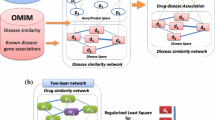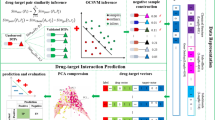Abstract
Finding the new related candidate diseases for known drugs provides an effective method for fast-speed and low-risk drug development. However, experimental identification of drug-disease associations is expensive and time-consuming. This motivates the need for developing in silico computational methods that can infer true drug-disease pairs with high confidence. In this study, we presented a novel and powerful computational tool, DR2DI, for accurately uncovering the potential associations between drugs and diseases using high-dimensional and heterogeneous omics data as information sources. Based on a unified and extended similarity kernel framework, DR2DI inferred the unknown relationships between drugs and diseases using Regularized Kernel Classifier. Importantly, DR2DI employed a semi-supervised and global learning algorithm which can be applied to uncover the diseases (drugs) associated with known and novel drugs (diseases). In silico global validation experiments showed that DR2DI significantly outperforms recent two approaches for predicting drug-disease associations. Detailed case studies further demonstrated that the therapeutic indications and side effects of drugs predicted by DR2DI could be validated by existing database records and literature, suggesting that DR2DI can be served as a useful bioinformatic tool for identifying the potential drug-disease associations and guiding drug repositioning. Our software and comparison codes are freely available at https://github.com/huayu1111/DR2DI.



Similar content being viewed by others
References
Paul SM et al (2010) How to improve R&D productivity: the pharmaceutical industry’s grand challenge. Nat Rev Drug Discov 9:203–214
Hodos RA et al (2016) In silico methods for drug repurposing and pharmacology. Wiley Interdiscip Rev Syst Biol Med 8:186
March-Vila E et al (2017) On the integration of in silico drug design methods for drug repurposing. Front Pharmacol 8:298
Vanhaelen Q et al (2016) Design of efficient computational workflows for in silico drug repurposing. Drug Discovery Today 22:210–222
Wang ZY, Zhang HY (2013) Rational drug repositioning by medical genetics. Nat Biotechnol 31:1080
Hurle MR et al (2013) Computational drug repositioning: from data to therapeutics. Clin Pharmacol Ther 93:335–341
von Eichborn J et al (2011) PROMISCUOUS: a database for network-based drug-repositioning. Nucleic Acids Res 39:D1060–D1066
Wishart DS et al (2008) DrugBank: a knowledge base for drugs, drug actions and drug targets. Nucleic Acids Res 36:901–906
Davis AP et al (2009) Comparative Toxicogenomics Database: a knowledgebase and discovery tool for chemical-gene-disease networks. Nucleic Acids Res 37:D786
Chen X, Ji ZL, Chen YZ (2002) TTD: Therapeutic target Database. Nucleic Acids Res 30:412–415
Iwata H et al (2015) Systematic drug repositioning for a wide range of diseases with integrative analyses of phenotypic and molecular data. J Chem Inf Model 55:446–459
Dudley JT, Deshpande T, Butte AJ (2011) Exploiting drug-disease relationships for computational drug repositioning. Briefings Bioinf 12:303–311
Gottlieb A et al (2011) PREDICT: a method for inferring novel drug indications with application to personalized medicine. Mol Syst Biol 7:496
Yang L, Agarwal P (2011) Systematic drug repositioning based on clinical side-effects. PLoS ONE 6:e28025
Wang Y et al (2013) Drug repositioning by Kernel-based integration of molecular structure, molecular activity, and phenotype data. PLoS ONE 8:e78518
Napolitano F et al (2013) Drug repositioning: a machine-learning approach through data integration. J Cheminf 5:30
Liang X et al (2017) LRSSL: predict and interpret drug-disease associations based on data integration using sparse subspace learning. Bioinformatics 33:1187–1196
Chiang AP, Butte AJ (2009) Systematic evaluation of drug-disease relationships to identify leads for novel drug uses. Clin Pharmacol Ther 86:507–510
Li J, Lu Z (2013) Pathway-based drug repositioning using causal inference. BMC Bioinf 14:1–10
Pratanwanich N, Lió P (2014) Pathway-based Bayesian inference of drug-disease interactions. Mol Biosyst 10:1538
Vogt I, Prinz J, Campillos M (2014) Molecularly and clinically related drugs and diseases are enriched in phenotypically similar drug-disease pairs. Genome Med 6:1–17
Yang J et al (2014) Drug-disease association and drug-repositioning predictions in complex diseases using causal inference-probabilistic matrix factorization. J Chem Inf Model 54:2562
Ye H, Liu Q, Wei J (2014) Construction of drug network based on side effects and its application for drug repositioning. PLoS ONE 9:e87864
Hu G, Agarwal P (2009) Human disease-drug network based on genomic expression profiles. PLoS One 4:e6536
Iorio F et al (2010) Discovery of drug mode of action and drug repositioning from transcriptional responses. Proc Natl Acad Sci USA 107:14621–14626
Lamb J et al (2006) The connectivity map: using gene-expression signatures to connect small molecules, genes, and disease. Science 313:1929–1935
Shigemizu D et al (2012) Using functional signatures to identify repositioned drugs for breast, myelogenous leukemia and prostate cancer. PLoS Comput Biol 8:e1002347
Sirota M et al (2011) Discovery and preclinical validation of drug indications using compendia of public gene expression data. Sci Transl Med 3:96ra77
Cheng F et al (2013) Prediction of human genes and diseases targeted by xenobiotics using predictive toxicogenomic-derived models (PTDMs). Mol Biosyst 9:1316–1325
Cheng F et al (2012) Prediction of drug-target interactions and drug repositioning via network-based inference. PLoS Comput Biol 8:e1002503
Huang YF, Yeh HY, Soo VW (2013) Inferring drug-disease associations from integration of chemical, genomic and phenotype data using network propagation. BMC Med Genomics 6:1–14
Wang W et al (2014) Drug repositioning by integrating target information through a heterogeneous network model. Bioinformatics 30:2923
Wu Z, Wang Y, Chen L (2013) Network-based drug repositioning. Mol Biosyst 9:1268–1281
Colby GT (2003) The comparative Toxicogenomics Database (CTD): a resource for comparative toxicological studies. Environ Health Perspect 111:793
Davis AP et al (2017) The comparative Toxicogenomics Database: update 2017. Nucleic Acids Res 45:D972–D978
Harden C, Maclusky NJ (2004) Aromatase inhibition, testosterone, and seizures. Epilepsy Behav 5:260–263
Reddy DS (2004) Testosterone modulation of seizure susceptibility is mediated by neurosteroids 3alpha-androstanediol and 17beta-estradiol. Neuroscience 129:195
Goyal R, Chandrasekaran R, Nanda MR (2007) Propranolol-responsive akathisia following acute encephalitis. Gen Hosp Psychiatry 29:273–274
Restivo A et al (2005) Antiproliferative effect of mimosine in ovarian cancer. J Clin Oncol 23:16_suppl
Kawakita T et al (1999) Benzoic acid compounds and use thereof as medicaments. US Patent No. 5,864,039
Sharma P, Pandey R, Deshpande S (2016) Indomethacin exacerbates oleic acid-induced acute respiratory distress syndrome in adult rats. Indian J Physiol Pharmacol 60:82–89
Zhang P et al (2013) Exploring the relationship between drug side-effects and therapeutic indications. In: AMIA annual symposium proceedings, vol. 2013, pp 1568–1577
Laarhoven TV, Nabuurs SB, Marchiori E (2011) Gaussian interaction profile kernels for predicting drug–target interaction. Bioinformatics 27:1–8
Yu H, Chen X, Lu L (2017) Large-scale prediction of microRNA-disease associations by combinatorial prioritization algorithm. Sci Rep 7:43792
Raymond R, Kashima H (2010) Fast and scalable algorithms for semi-supervised link prediction on static and dynamic graphs. In: European conference on machine learning and knowledge discovery in databases, vol 1. Springer, Heidelberg, pp 131–147
Yu H et al (2012) A systematic prediction of multiple drug-target interactions from chemical, genomic, and pharmacological data. Plos ONE 7:e37608
Jeanette P et al (2016) A novel drug-mouse phenotypic similarity method detects molecular determinants of drug effects. PLoS Comput Biol 12:e1005111
Author information
Authors and Affiliations
Contributions
LL and HY conceived the original research plans, analyzed the data and wrote the article; HY and LL supervised the experiments and revised the paper.
Corresponding authors
Ethics declarations
Conflict of interest
The authors declare no competing financial interests.
Electronic supplementary material
Below is the link to the electronic supplementary material.
Rights and permissions
About this article
Cite this article
Lu, L., Yu, H. DR2DI: a powerful computational tool for predicting novel drug-disease associations. J Comput Aided Mol Des 32, 633–642 (2018). https://doi.org/10.1007/s10822-018-0117-y
Received:
Accepted:
Published:
Issue Date:
DOI: https://doi.org/10.1007/s10822-018-0117-y




